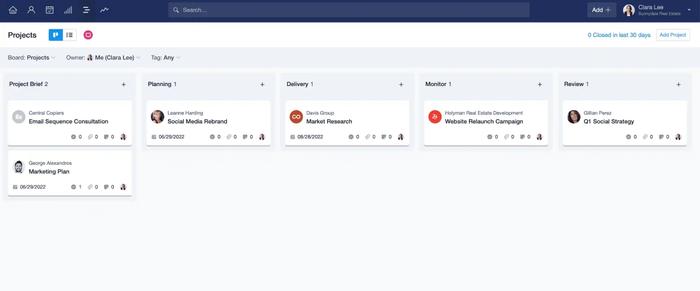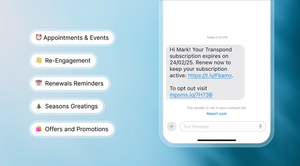Many issues can negatively impact your marketing team's productivity. Examples include workplace distractions, poor morale, lack of professional development opportunities, unproductive meetings, and other examples of 'work about work' — activities that take time away from meaningful tasks.
In fact, an Asana survey found that the average employee spends almost two-thirds of their typical office day on 'work about work,' preventing them from being truly productive.
However, understanding the leading causes of lost productivity is only half the battle. You also need to know the specific steps that can be taken to overcome these issues.
In this article, we’ll identify the things you can do to improve your marketing team's productivity.
Make information easy to access
For marketing teams, one of the biggest drains on productivity is a lack of organization, leading to time being wasted looking for information.
Your business has likely accumulated lots of data on existing and potential customers, and your various marketing strategies, but it's only useful if your marketers know where to find the data.
The best way to solve this problem is to use software to centralize as much data as possible.
Not only will this make data easier to find, because marketers will know exactly where to look, it also allows multiple users to access the data, make changes, and share information with one another.
For instance, a content management system can be used to centralize and manage marketing content.
This then allows multiple users to create, edit, publish and remove content from your website, blog, or social media channels. The centralization of data streamlines content creation processes and ensures everyone uses the same tools and goes to the same place to manage content.
Similarly, a high-quality CRM solution allows you to store customer data and contact information in one place. With a tool like Capsule, you can import Outlook, Google, vCard, CSV and spreadsheet contacts and a quick-search function lets you easily find individual contacts.
For each contact, you can also access past interactions, social media handles, and much more.
Ultimately, the more organized your data is, the more productive your marketing team can be. They'll spend less time looking for valuable information and use more of their time trying to achieve your business objectives.
Cater to remote and hybrid workers

Remote working models have become increasingly popular, especially since the COVID-19 pandemic.
“According to WFH Research, in April 2023, 28% of all paid working days in the United States were worked from home.”
Almost 12% of full-time job holders work from home, while 29% are on a hybrid model (work from home and on-site). Similar figures can be seen across the EU.
If your marketing team employs remote workers, it's important to cater to their specific needs. In addition, you can explore some other ideas to improve team performance, including:
- Creating a basic weekly schedule for your marketing team to stick to.
- Using video conferencing tools to check in with remote workers regularly.
- Working with individuals to set clear goals and expectations.
- Making important data readily accessible for remote workers.
- Creating online learning and professional development material.
The issue of scheduling can be especially important for productivity. While a certain amount of flexibility will be needed to deal with unexpected events — or unforeseeable opportunities — you need to be clear about the work that needs to be done and who's responsible for doing it.
Again, it's useful to have scheduling information and details about specific tasks all in one place.
Automate repetitive and predictable tasks
According to WorkMarket and KRC Research, 74% of all respondents — business leaders and employees — believed that parts of their job could be automated.
“Among business leaders, 70% stated that they spend between 45 minutes and three hours working on mundane tasks that aren't core to their job description.”
Meanwhile, 53% of employees felt they could save up to two hours a day by automating certain tasks.
Various aspects of CRM can also be automated using software. While lead scoring takes many forms, predictive lead scoring is an automated process, which uses machine learning to analyze the data you have collected.
It can learn from trends among your customers and from leads that didn’t close, and will then assign a score to each lead, allowing you to prioritize the most promising ones.
Marketing emails are also simple to automate. The basic approach is to design email templates for specific purposes and then create an automated workflow that sends an email only if certain conditions are met.
For instance, after someone signs up for your mailing list, you could send them an automated welcome email containing a special offer or discount code.
You could also request a customer review after they've made a purchase.
The process for both situations can be automated, allowing you to specify how much time should pass between the event that triggers the email being sent and the email actually being sent.
Follow a basic team effectiveness model
Sometimes, going back to the basics when trying to ramp up team productivity levels is useful. This can include using a team effectiveness model to evaluate the current state of your team.
If you're unsure whether your marketing team has all the components they need to achieve optimal productivity, you can use the GRPI Model of Team Effectiveness to assess the current state.
The GRPI model stands for:
- Goals
- Roles
- Processes
- Interactions
According to research from Noel Tichy, who analyzed team conflicts based on the GRPI framework, having no clear goals is to blame for most conflicts.
The remaining issues are primarily attributed to the lack of clarity surrounding job roles and responsibilities.
When those two issues are removed, the leading cause of conflicts is confusion about processes and procedures.
Interpersonal relationships and interactions are the final major cause of problems.
In other words, teamwork in the workplace can be greatly enhanced by focusing on these issues.
- First, make sure your marketing team has clear goals and objectives.
- Then, you should ensure job roles are clearly defined and leaders are known and respected.
- Next, you need to establish clear work processes.
- Finally, you need to take appropriate steps to boost the effectiveness, speed, and overall clarity of communication.
Offer professional development opportunities

Giving your team professional development opportunities is a proven way to improve productivity.
In fact, according to research compiled by the Harvard Business Review, organizations with a strong learning culture are 52% more productive.
“Having a strong learning culture, and offering professional development opportunities leads to a workforce that is, on average, 15% more engaged, with employee retention rates between 30% and 50% higher than in organizations without a strong learning culture.”
Put simply, employees are more likely to take an active interest in work and stay with an organization if they believe their work matters and there are opportunities to develop their careers.
Offering seminars, webinars, and courses that result in employees earning recognized qualifications are all good ways of providing development opportunities.
You can also work with team members to create personal development plans. These plans should clearly outline each individual’s specific goals, while breaking down existing skills and skills they need to acquire to reach those goals.
From there, break the goals down into individual, achievable steps that will lead to the eventual end goal. Objectives should also be organized into priority order.
However, it's also important to develop a culture that rewards this development through promotion opportunities and internal recruitment rather than always turning to external candidates when vacancies arise. This helps keep employees motivated and will make them feel more valued.
Also, you can aid the professional development of your marketing team by creating a mentorship scheme.
By placing less experienced team members in direct contact with those who are more experienced, competent and further along in their careers, you can improve your team's productivity in the workplace.
Capitalize on artificial intelligence
Artificial intelligence (AI) technology is improving rapidly, and it has become a major topic of discussion for marketing content creation.
While organizations have diverse opinions and approaches regarding the use of AI, it can quickly generate content ideas and can be used to create preliminary drafts.
ChatGPT may be the best-known AI tool and it can be used to generate unique content quickly, based on prompts.
However, alternatives, such as Jasper, have been designed specifically with marketing content in mind, making it more purpose-built.
Jasper also goes further, as it can be used to create unique images and graphics, which can also form part of a marketing strategy.
Most AI solutions of this kind follow the same basic process. The user sets parameters and enters prompts, which help to explain what kind of content is needed and what the requirements are for the final text.
The AI then takes this information and generates content, which can then be amended if necessary.
Capsule's AI Content Assistant feature is especially useful for creating email marketing content quickly. Using this tool, your employees can simply describe the basics of what the email should cover, select the preferred tone and set the length of the email.
The text will then automatically be generated. You can tweak the content or request rewrites with specific parameters since you maintain full control.
“In addition to writing emails and other content much faster, AI can help you overcome writer's block.”
When writing, a significant amount of time is wasted trying to develop ideas for content that will appeal to the target audience. With AI, a list of ideas can be generated quickly, enabling you to select the best options.
While you may need to provide some basic training, the good news is that modern AI solutions, such as those powered by ChatGPT, are easy to use and can produce useful and worthwhile results in a matter of minutes.
Make use of analytics
For your marketing team's time to be considered truly productive, they should be helping you achieve your marketing goals.
That means spending time on the right activities and targeting the right individuals with marketing content.
One of the best ways to maximize the effectiveness of your marketing strategy is to make intelligent use of analytics.
For example, software tools should allow you to view key performance indicators (KPIs) for email marketing campaigns, such as:
- The number of recipients who opened the email
- The number of people who clicked on links
- The number of users who unsubscribed from your mailing list
With these KPIs, it becomes much easier for your marketing team to understand the types of content that work well with a particular audience and the types that don’t perform well or cause people to unsubscribe.
Marketers should also track website and web content metrics. Of course, the metrics that matter most will depend on the nature of your business.
Some of the key analytics metrics to track using tools like Google Analytics include:
- Page views
- Conversions
- Bounce rates
- Length of sessions
By making intelligent and effective use of KPIs, you can modify future campaigns and ensure that time is spent creating the kind of marketing content most likely to attract attention or boost sales.
If you start to find that certain types of content are leading to a high bounce rate or low session length, or are failing to generate conversions, you can shift focus to high-performing types of content instead.
Use software to manage and monitor projects
A great way to boost team productivity within marketing departments is to use software to manage and monitor projects as they progress.
Utilizing software that allows this while providing your employees visibility into projects' progress can be especially useful.
The result is a more transparent project management process, where all members of your team understand the scale of the work ahead and know where things currently stand.
Capsule allows you to manage projects from within your CRM software, making it easy to keep all your important information in one place.
You can create Kanban-style project boards, divide projects into multiple stages, outline the work that needs to be carried out and establish clear goals for the team to work towards.

For each project, it is important to provide easy-to-access updates.
With effective project management, you should know how far the project has advanced and which team members are working on which tasks.
This also makes it easier to find bottlenecks and understand which project areas are taking up the most time so that improvements can be made, resources can be appropriately allocated and productivity can be increased.
Unlock your marketing team's productivity
Lost productivity is a serious problem within all business departments. For example, productivity issues in the marketing team can lead to lost opportunities to attract new customers or retain existing ones.
By following these steps, you can reduce unnecessary time wasted looking for information, improve employee engagement, monitor projects and cater to employees working from home.
With the right software, you can capitalize on automation and AI technology to reduce workloads and improve your team's productivity.
Click here to learn more about Capsule CRM and access a 14-day free trial.




